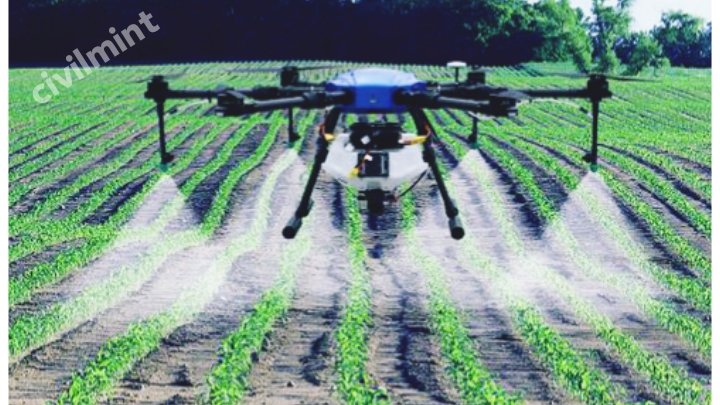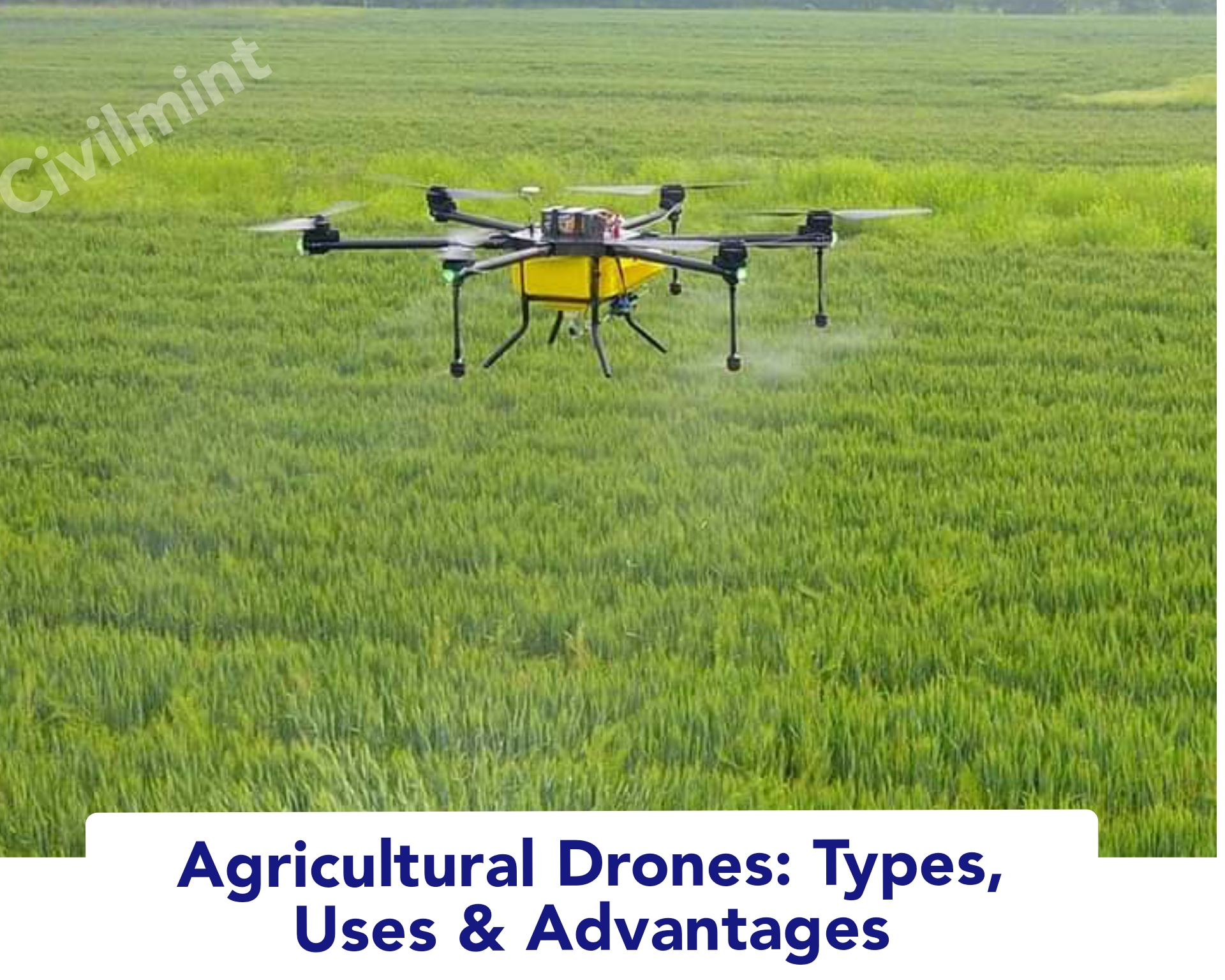Agricultural drones are important in modern farming because they increase crop management and efficiency. These unmanned aerial vehicles can increasingly monitor large farms, assess crop health and accurately apply pesticides or fertilizers, reducing resource waste and increasing yields. Agricultural drones provide valuable data for decision making, ultimately contributing to sustainable and productive agriculture.
Table of Contents
What Is Agricultural Drone?
Agricultural drones, also known as unmanned aerial vehicles (UAVs), play an important role in farming. Farmers use these flying machines to make their fields more productive and keep track of how their crops are doing.
One of the main functions of agricultural drones is to monitor plants as they grow. They take photos and gather data to show how healthy the crops are and how big they are growing.

Farmers love agricultural drones because they help increase the amount of food grown on the farm. Drones do this by giving farmers vital information about their crops and land.
Imagine that a doctor is checking your health. Drones do something similar for plants. They can detect when a crop is not doing well and let the farmer know so they can help.
Drones are like spies for the soil. They fly above the ground, using special sensors to detect what is happening beneath the surface.
These drones use a cool gadget called a multispectral sensor. These sensors can see things that the human eye cannot, such as light waves that are not visible. It’s like having a superpower to learn more about plants and soil.
Multispectral sensors on drones can see light waves that our eyes cannot see, such as infrared light. This helps us look at plant health in a whole new way.
When plants are healthy, they shine in a way our eyes can’t see. But drones can detect this glow, which will help farmers know whether their crops are growing well or not.
Drones can also detect whether the soil in one part of the field is different from another part. This helps farmers decide how much water and food to apply to different parts of the field.
As technology improves, agricultural drones are becoming even better at helping farmers. They are like a farmer’s helpers, always keeping an eye on the farm and helping to grow more food.
Types Of Agricultural Drones
1. Fixed-Wing Drones
Fixed-wing drones in agriculture look like small airplanes. Unlike multi-rotor drones, they can stay in the air for longer periods and cover more ground. These drones are commonly used to map fields, monitor crops, and identify potential issues like pests or irrigation problems.
They are also used for surveying, mapping, and aerial photography. Fixed-wing drones are favored for precision agriculture due to their long flight time and ability to cover larger areas. However, they can be more challenging to fly than multi-rotor drones due to their complexity and the need for open space to take off and land.
2. Single-Rotor Drones
Single-rotor drones, also known as helicopter drones, are larger and more expensive than multi-rotor drones. They can take off and land vertically, allowing them to hover in place and fly with precision. These drones are typically used for specific tasks like crop monitoring, irrigation management, soil analysis, and plant counting.
They can carry advanced sensors and cameras for collecting data on crop health, soil conditions, and environmental factors. While they offer longer flight times and better payload capacity, they are also more complex to operate and maintain.
3. Multi-Rotor Drones
Multi-rotor drones are a popular choice in agriculture. They have multiple rotors mounted on their body, making them highly maneuverable and suitable for close-range operations like crop monitoring and analysis.
Farmers use multi-rotor drones for mapping large agricultural areas, capturing high-resolution aerial imagery, detecting crop health issues, and monitoring for pests and diseases. These drones can hover in place for precise data collection but have shorter flight times and ranges compared to fixed-wing drones.
4. Hybrid Drones
Hybrid drones combine the advantages of fixed-wing and multi-rotor drones. They have both vertical take-off and landing (VTOL) capabilities, making them versatile for various agricultural tasks. Hybrid drones can launch and land vertically, even in confined or uneven terrain, and then fly horizontally for extended periods.
They are equipped with sensors and cameras for tasks such as crop mapping, health assessment, irrigation management, and pesticide spraying. Hybrid drones excel in large-scale farming operations due to their extended range and endurance. They can also operate in a wider range of weather conditions, thanks to their VTOL capability. However, they are more complex, expensive, and require specialized training and maintenance.
Uses Of Agricultural Drones
1. Land Imaging
Land Imaging is one of the primary functions of agricultural drones. Drones equipped with high-resolution cameras capture detailed aerial images of farmland. These images help farmers monitor the overall condition of their land, identify potential issues, and make informed decisions about crop management.
2. Surveying Topography and Boundaries
Agricultural drones are instrumental in surveying topography and boundaries. They can create accurate topographic maps of fields and delineate property boundaries, assisting farmers in land management and ensuring compliance with land-use regulations.
3. Soil Monitoring
Soil monitoring is crucial for optimizing crop growth. Drones equipped with specialized sensors can assess soil quality, moisture levels, and nutrient content. This data enables farmers to tailor their irrigation and fertilization strategies for maximum crop yield.
4. Livestock Movement and Counting
For livestock farming, drones help in monitoring livestock movement and counting. Drones can fly over pastures and corrals to keep track of the number and health of animals, identify any issues, and improve overall herd management.
5. Irrigation Monitoring
Irrigation monitoring is essential for efficient water use in agriculture. Drones can inspect irrigation systems, detect leaks, and assess water distribution, ensuring that crops receive the right amount of water while conserving this precious resource.
6. Spraying Needs
Agricultural drones with spraying equipment offer precise spraying needs solutions. They can target specific areas of a field with pesticides, herbicides, or fertilizers, reducing chemical usage, minimizing environmental impact, and lowering operational costs.
7. Collecting Soil and Water Samples
Drones are capable of collecting soil and water samples from various locations across a farm. This allows for comprehensive analysis, helping farmers make data-driven decisions about soil health, contamination, and the suitability of water sources.
8. Troubleshooting
Drones can assist in troubleshooting by identifying potential problems before they escalate. They can quickly spot issues such as crop diseases, pest infestations, or equipment malfunctions, enabling timely interventions to prevent significant losses.
Advantages of Agricultural Drones
1. Time Savings
Agricultural drones save farmers significant time compared to traditional methods of monitoring and assessment. They provide real-time data, allowing farmers to make quick decisions and respond promptly to issues.
2. Improved Data Quality
Drones offer high-definition imagery and sensor data, providing farmers with improved data quality. This enhanced information helps in making precise decisions about crop health, irrigation, and soil management.
3. Enhanced Safety
The use of drones enhances safety in agriculture. They can assess dangerous or hard-to-reach areas, reducing the need for human workers to enter hazardous environments. This improves worker safety and speeds up post-disaster damage assessment.
4. Cost Savings
Agricultural drones contribute to cost savings by optimizing resource use. They enable more efficient irrigation, reduced chemical application, and improved crop yields, ultimately leading to increased profitability.
You might also like: Drone Survey
5. Environmental Benefits
By allowing precise application of pesticides and fertilizers, agricultural drones help reduce environmental impact. They minimize chemical runoff and drift, protect nearby ecosystems, and decrease air pollution compared to traditional spraying methods.

